Choosing the perfect lighting for your residential or commercial spaces can indeed present a daunting challenge. However, in the quest to pick out the perfect fixtures, the significance of the humble light switch often gets overlooked. This is unfortunate, considering that an appropriately selected light switch can not only augment the convenience and functionality of your lighting system but also boost the aesthetic appeal of any space.
To ensure you make a well-rounded decision, we present an easy-to-understand guide showcasing the common types of light switches available for your consideration.
Disclaimer: The information provided in this blog post is intended to offer general knowledge about light switches and their functionality. While we strive to present accurate and up-to-date information, working with electricity can be dangerous if not handled properly. If you’re considering replacing or installing light switches in your home or commercial premises, we strongly recommend hiring a licensed electrician to perform the task.
Single-Pole Light Switch
A single-pole switch is the most common type of light switch that you’ll find in a home. This type of switch controls a single light fixture or a series of fixtures from one location. It has two brass terminal screws and a toggle labeled “ON” and “OFF.”
In terms of its function, the single-pole switch completes or interrupts the circuit path, thereby turning the light on or off. To make it clearer, when you flip the switch to the “ON” position, it completes the circuit, allowing electricity to flow to the light fixture and turn it on. Conversely, when you flip the switch to the “OFF” position, it interrupts the circuit, stopping the flow of electricity to the light fixture and turning it off.
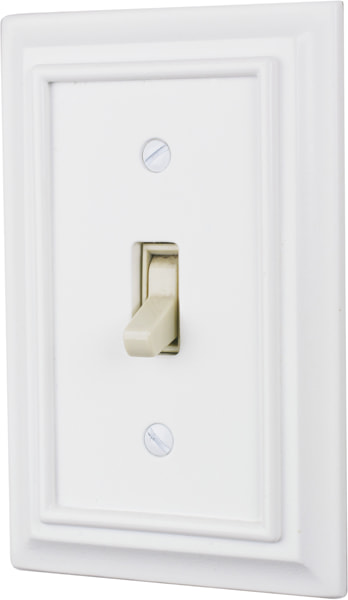
Double-Pole Light Switch
A double-pole switch, often referred to as a DP switch, is a type of electrical switch that operates two separate circuits simultaneously. It has four terminal screws, two for the incoming ‘hot’ wires and two for the outgoing ‘hot’ wires. Unlike the single-pole switch, which controls just one fixture from a single location, a double-pole switch is designed to control two separate devices, or a device that requires a 240-volt power supply from a single location.
When activated, a double-pole switch connects or disconnects both circuits at the same time. Essentially, when you turn the switch to the “ON” position, it completes both circuits, allowing electricity to flow through them and powering the devices connected to those circuits. Conversely, when you flip the switch to the “OFF” position, it interrupts both circuits, cutting off the flow of electricity and turning off the connected devices.

Dimmer Switch
A dimmer switch is a type of light switch that allows you to adjust and control the brightness level of the light fixture it is connected to. Instead of merely turning the lights on or off, a dimmer switch lets you set the desired light intensity, allowing you to create the perfect ambiance for any occasion. Operating a dimmer switch is generally straightforward. Traditional rotary dimmers work by rotating a knob to increase or decrease the intensity of the light. Slide dimmers, on the other hand, feature a slider along with an on/off switch. Some newer models even offer touch or remote control capabilities for added convenience.
It’s important to note that not all light bulbs are dimmable, so you need to ensure you’re using dimmable bulbs with your dimmer switch.

Rocker Switch
A rocker switch, similar to a toggle switch, controls light operation by rocking up or down or side to side instead of flipping a lever. Press the top to switch the light on and the bottom to switch it off. Both types of switches are equally reliable, with preference often coming down to personal taste. However, a rocker switch’s sleeker profile could be a plus in tight spaces to prevent snagging on clothing or objects.
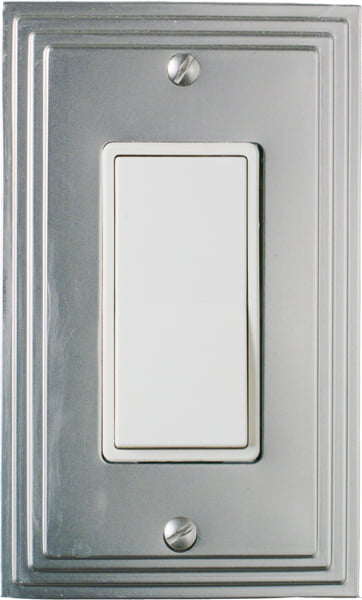
Combination Light Switch
A combination switch not only operates a light but also provides a 3-prong grounded electrical outlet. This switch type is an excellent choice for rooms needing additional or better-placed outlets, as it’s much simpler to replace a switch than to install a new outlet in drywall. They’re commonly used in bathrooms and kitchens.
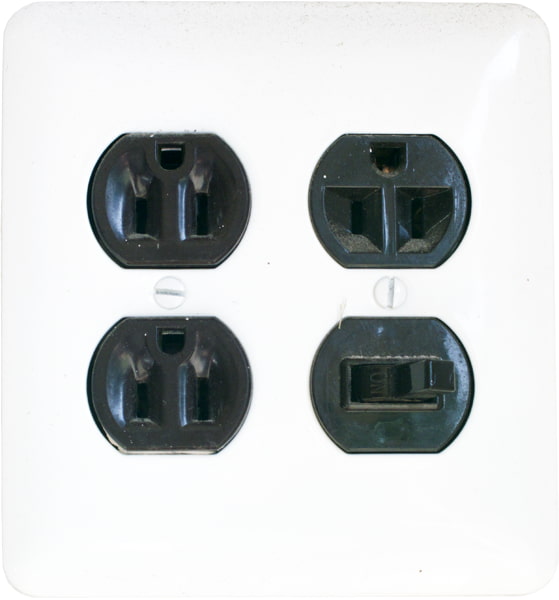
Double Light Switch
A double light switch, also known as a dual or two-gang switch, is a type of switch that controls two separate light fixtures from a single location. Each fixture can be turned on or off independently, allowing for greater control and flexibility.

Triple Light Switch
Looking to control multiple lights independently from a single location in a room or hallway? A triple switch is your solution. It’s available in both rocker and toggle designs. Unlike a standard single pole toggle switch that only offers “all on” or “all off” options, a triple switch lets you operate each light separately. However, don’t confuse triple switches with three-way switches; the latter control a single light from different locations.
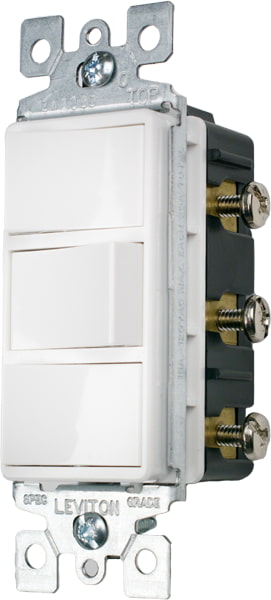
Three-Way Switch / Four-Way Switch
A three-way switch, different from a double or triple switch, enables you to control one light from multiple locations. Also known as a “multiway” or “hallway switch,” it lets you switch a light on at one end of a hallway and off at the other. Wiring a three-way switch can be more complex, so ensure you research thoroughly before installation. Key identifiers of a three-way switch include the lack of “on” or “off” markings (as the state depends on the other switch’s position) and three screw terminals, plus a green grounding screw on the switch body.
A four-way light switch is used in combination with two three-way switches to control a light or group of lights from three or more locations. The name “four-way” originates from the switch having four terminal screws, used to connect the switch in a circuit between the two three-way switches.
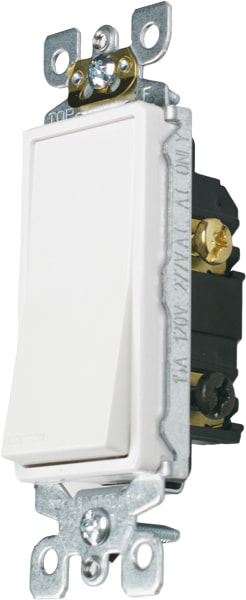
Photocell Switch
Photocells, also known as photosensors, are sensors commonly used in lighting systems to detect the levels of light in the environment. When a photocell is incorporated in an LED light, it automatically controls the operation of the light based on the surrounding light intensity. For example, as daylight fades and light levels decrease, the photocell sensor triggers the light to switch on. Photocells are either integrated into the lighting fixture itself, or sold separately as an accessory that can attach to compatible fixtures. Fixtures that utilize photocell technology are often referred to as “dusk till dawn lights” and are commonly seen in outdoor lighting applications such as area/flood lights, street lights, or wall packs.
There’s usually a switch to turn the photocell functionality on or off; however, this depends entirely on the brand and type of light you’re using.
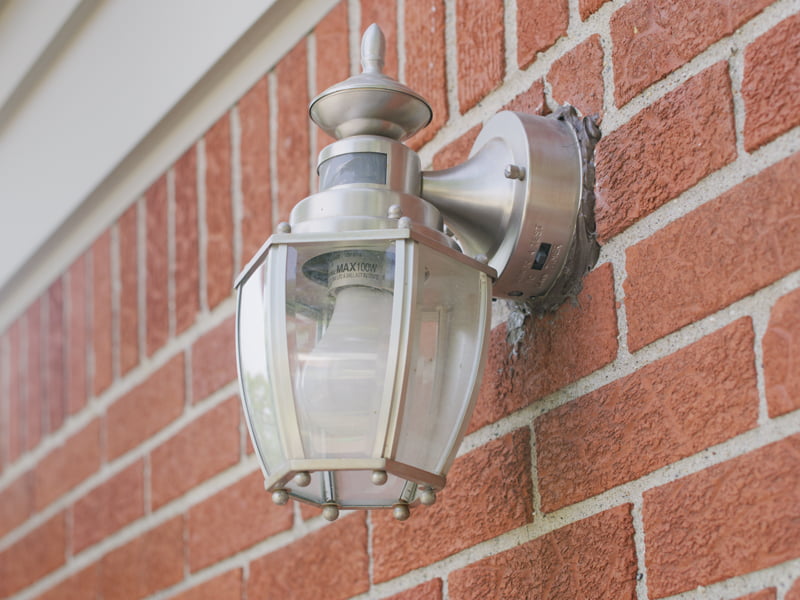
Motion Sensor Light Switch
A motion sensor light switch, also known as an occupancy sensor or vacancy sensor, is a type of electrical switch that turns lights on and off based on the detection of movement within a specific area. This type of switch uses infrared, ultrasonic, or microwave technology to detect motion. Motion sensors on lights are typically found in strategic locations that allow for optimal detection of movement in the area they’re designed to monitor. Motion sensors are generally integrated into the fixture itself or sold separately as an accessory item. The precise location can vary depending on the specific type and model of the light fixture.

Timer Light Switch
A timer switch is an electrical device designed to automatically turn an appliance or light on or off at specific preset intervals. Unlike traditional switches that rely on manual operation, timer switches are programmed to activate or deactivate electrical circuits at designated times, enhancing energy efficiency and user convenience. Commonly found in both residential and commercial settings, these switches can be particularly useful for tasks like controlling outdoor lighting

